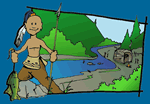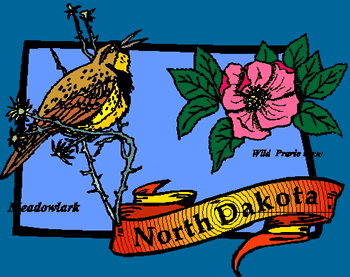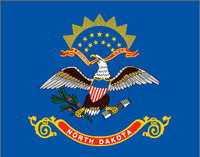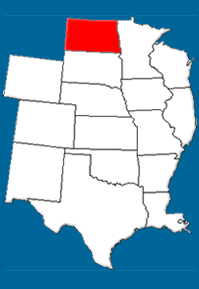


Geography and Landforms:
North Dakota is bordered by Canada on the north and by South Dakota on the south. On the east, North Dakota is bordered by Minnesota, and on the west, it is bordered by Montana. The highest point in North Dakota is White Butte at 3,506 feet above sea level. Major rivers include the James River, the Missouri River and the Red River.
|
 History:
North Dakota was explored in 1738-1740 by French Canadians led by Sieur de la Verendrye, who had traveled throughout Canada in search of a water passage to the Pacific Ocean. Because of the importance of the fur trade, Spain, Britain and France all wished to establish a presence in the area. But after the Treaty of Paris ending the French and Indian War, Great Britain took possession of all French lands drained by Hudson's Bay. By 1800, the land had been returned to France, but in 1803, it was sold to the United States by Napoleon Bonaparte as part of the Louisiana Purchase. Meriwether Lewis and William Clark explored the region in 1804-1806. The first settlements were made at Pembina in 1812 by Scottish and Irish families while this area was still in dispute between the U.S. and Great Britain. In 1818, the London Convention set the 49th parallel as the northern border of the US. However, the region remained largely unsettled until the construction of the railroad in the 1870s and 1880s. In fact, the Pembina settlement remained the only farm settlement in the state until 1851 when Dakota Territory was organized. |
 Economy:
North Dakota is the most rural of all the states, with farms covering more than 90% of the land. North Dakota ranks first in the nation's production of spring and durum wheat; other agricultural products include barley, rye, sunflowers, dry edible beans, honey, oats, flaxseed, sugar beets, hay, beef cattle, sheep, and hogs. |
 First Inhabitants:
Before Europeans began settling in the Northern Plains in the 19th century, the land had been home to people for many centuries. Archeologists tell us that big game hunters began to occupy the land we now call North Dakota as soon as the glaciers retreated at the end of the Ice Age, probably about 10,000 years ago. There is also evidence of hunter/gatherer cultures and farming cultures from about 2000 BC up until the arrival of European explorers and settlers.
|
Books Related To North DakotaBad River Boys: A Meeing of the Lakota Sioux with Lewis and Clark - Virginia Driving Hawk Sneve Betrayed! - Patricia Calvert Blizzard's Wake - Phyllis Reynolds Naylor Jake's Orphan - Peggy Brooke P is for Peace Garden: A North Dakota Alphabet - Roxane Salonen River Friendly, River Wild - Jane Kurtz Wild Life - Cynthia DeFelice |
Famous Citizens:
|
| Capital: | Bismarck |
| Entered Union: | November 2, 1889 |
| Population: | 739,482 |
| Area | 70,700 |
| Bird | Western Meadowlark |
| Flower | Wild Prairie Rose |
| Nickname: | Peace Garden State, Flickertail State |
| Governor | Jack Dalrymple |
Places to Visit in North Dakota: (Click the links to learn more.)
|



